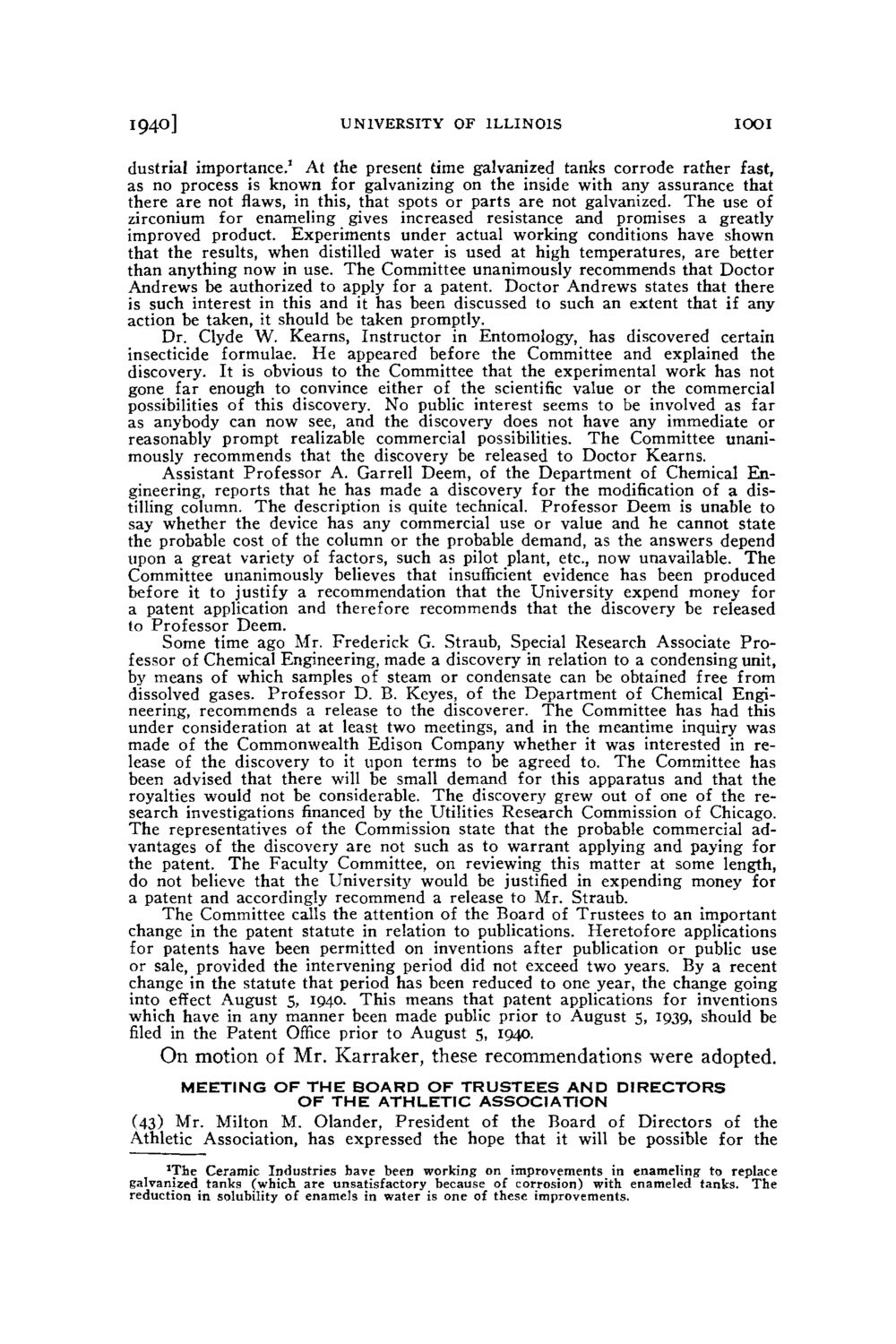| |
| |
Caption: Board of Trustees Minutes - 1940
This is a reduced-resolution page image for fast online browsing.

EXTRACTED TEXT FROM PAGE:
1940] U N I V E R S I T Y OF ILLINOIS IOOI dustrial importance.' At the present time galvanized tanks corrode rather fast, as no process is known for galvanizing on the inside with any assurance that there are not flaws, in this, that spots or parts are not galvanized. T h e use of zirconium for enameling gives increased resistance and promises a greatly improved product. Experiments under actual working conditions have shown that the results, when distilled water is used at high temperatures, are better than anything now in use. T h e Committee unanimously recommends that Doctor Andrews be authorized to apply for a patent. Doctor Andrews states that there is such interest in this and it has been discussed to such an extent that if any action be taken, it should be taken promptly. Dr. Clyde W. Kearns, Instructor in Entomology, has discovered certain insecticide formulae. H e appeared before the Committee and explained the discovery. It is obvious to the Committee that the experimental work has not gone far enough to convince either of the scientific value or the commercial possibilities of this discovery. No public interest seems to be involved as far as anybody can now see, and the discovery does not have any immediate or reasonably prompt realizable commercial possibilities. T h e Committee unanimously recommends that the discovery be released to Doctor Kearns. Assistant Professor A. Garrell Deem, of the Department of Chemical Engineering, reports that he has made a discovery for the modification of a distilling column. T h e description is quite technical. Professor Deem is unable to say whether the device has any commercial use or value and he cannot state the probable cost of the column or the probable demand, as the answers depend upon a great variety of factors, such as pilot plant, etc., now unavailable. T h e Committee unanimously believes that insufficient evidence has been produced before it to justify a recommendation that the University expend money for a patent application and therefore recommends that the discovery be released to Professor Deem. Some time ago Mr. Frederick G. Straub, Special Research Associate P r o fessor of Chemical Engineering, made a discovery in relation to a condensing unit, by means of which samples of steam or condensate can be obtained free from dissolved gases. Professor D. B. Keyes, of the Department of Chemical Engineering, recommends a release to the discoverer. T h e Committee has had this under consideration at at least two meetings, and in the meantime inquiry was made of the Commonwealth Edison Company whether it was interested in release of the discovery to it upon terms to be agreed to. T h e Committee has been advised that there will be small demand for this apparatus and that the royalties would not be considerable. T h e discovery grew out of one of the research investigations financed by the Utilities Research Commission of Chicago. T h e representatives of the Commission state that the probable commercial advantages of the discovery are not such as to warrant applying and paying for the patent. T h e Faculty Committee, on reviewing this matter at some length, do not believe that the University would be justified in expending money for a patent and accordingly recommend a release to Mr. Straub. T h e Committee calls the attention of the Board of Trustees to an important change in the patent statute in relation to publications. Heretofore applications for patents have been permitted on inventions after publication or public use or sale, provided the intervening period did not exceed two years. By a recent change in the statute that period has been reduced to one year, the change going into effect August 5, 1940. This means that patent applications for inventions which have in any manner been made public prior to August 5, 1939, should be filed in the Patent Office prior to August 5, 1940. On motion of Mr. Karraker, these recommendations were adopted. MEETING OF T H E BOARD OF TRUSTEES AND DIRECTORS OF THE ATHLETIC ASSOCIATION (43) Mr. Milton M. Olander, President of the Board of Directors of the Athletic Association, has expressed the hope that it will be possible for the 1 The Ceramic Industries have been working on improvements in enameling to replace galvanized tanks (which are unsatisfactory because of corrosion) with enameled tanks. The reduction in solubility of enamels in water is one of these improvements.
| |